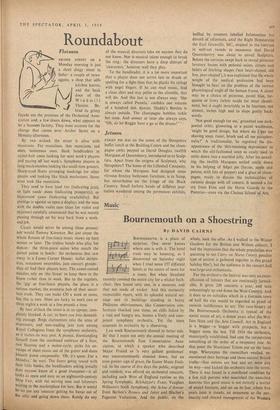Roundabout
Flotsam
By two o'clock the street is alive with musicians. Fat musicians, thin musicians, sad ones, boisterous ones. Sleek bandleaders in camel-hair coats looking for next week's players and paying off last week's. Symphony players in long mackintoshes looking like small-time grocers. Sharp-eyed fixers arranging bookings for other people and looking like black marketeers. Some even look like musicians.
They tend to have loud ties (indicating jazz), or light suede shoes (indicating prosperity), or instrument cases (indicating availability). But prestige is against so open a display; and the man With the double violin case (duet for violin and pyjamas) carefully announced that he was merely passing through on his way back from a week- end job.
Casals would never be among those present; nor would Tommy Kinsman. But just about the whole flotsam of free-lance music shows up here sooner or later. The tireless bands who play for dances : the three-piece suites who match the potted palms in hotels: the orchestras that saw away in a Lyons Corner House: ballet orches- tras, restaurant ensembles, jazz concert groups: they all find their players here. The camel-coated steadies rely on 'the Street' to keep them in the know rather than in work. But to the regulars, the 'gig' or free-lance players, the place is a serious market, the eccentric hub of their uncer- tain trade. They can make £30 a week or more, but this is rare. Most are lucky to work two or three nights a week at a few pounds a time.
By four o'clock the street is in an uproar, corn- Pletely blocked. A car, its horn con brio demand- ing passage, flings clarinettists into the arms of drummers, and non-reading jazz men among Royal Collegians from the symphony orchestra, as it inches its way past. A pianist, disentangling himself from the combined embrace of a fixer, two flautists and a motor-cycle, picks his en- velope of sheet music out of the gutter and dusts himself down composedly. 'Oh, it's quiet. For a Monday,' he says. The fixers going round with their little books, the bandleaders asking jovially does anyone know of a good teumpeter—it all looks as open and easy as an eighteenth-century Mop Fair, with the serving men and labourers waiting in the marketplace for hire. But it would be no use any amateur getting his banjo out of the attic and going down there. Rarely do any of the musical directors take on anyone they do not know. Nor is musical talent enough to break the ring: the directors have a deep distrust of 'characters,' however well they play.
To the bandleader, it is a lot more important that a player does not arrive late or drunk or spoiling for a fight than that he plucks his strings with angel fingers. If he can read music, find a clean shirt and stay polite to the clientele, that will do. And this last is not always easy. 'She is always called Pamela,' confides one veteran of a hundred deb. dances. 'Daddy's Bentley is always outside. The champagne bubbles tickle her nose. And sooner or later she always says, "Oh, do let' Reggie have a go at the drums!"' -
Jetsam
FIDGET PIE was on the menu of the Shropshire buffet lunch at the Building Centre and the cham- pagne corks popped as David Douglas, twelfth Marquess of Queensberry, introduced us to Sculp- tura. Apart from the enigma of Sculptura, why Shropshire? The home of the Lilleshall Company, for whom the Marquess had designed some vitreous fireclay bathroom furniture, is in Salop, but nevertheless on the fringe of the Black Country. Small forlorn bands of diffident jour- nalists wandered among the permanent exhibits, baffled by counters labelled Information but devoid of informers, until the Right Honourable the Earl Granville, MC, stepped to the rostrum in well-cut tweeds to announce that David Queensberrry was about to unveil Sculptura. Before the curtains swept back to reveal primrose lavatory basins with pedestal suites, closets and bidets of fetching shapes ('not heart-shaped, old boy, pear-shaped'), it was explained that the whole weight of the medical profession had been brought to bear on the problem of the correct physiological angle of the human frame. A closet may be a choice of primrose, pastel blue, tur- quoise or ivory (white inside for inner cleanli- ness), but it ought invariably to be fourteen, not sixteen, inches high and to slope gently back- wards.
'Not good enough for me,' grumbled one dark- jowled critic, glowering at a pastel washbasin, 'might be good design, but where do I put me shaving soap, razor, brush and all me parapher- nalia?' A traditionalist, he regretted the dis- appearance of the 'dirt-retaining depressions' in which the old-fashioned soap so cosily used to settle down into a marbled jelly. After his unveil- ing, the twelfth Marquess settled cosily down to his helping of fidget pie (bacon, apple and potato, with lots of pepper) and a glass of cham- pagne, ready to discuss the technicalities of ceramic design with all corners. It seemed a far cry from Eton and the Horse Guards to the Potteries—even via the Chelsea School of Art.


































 Previous page
Previous page